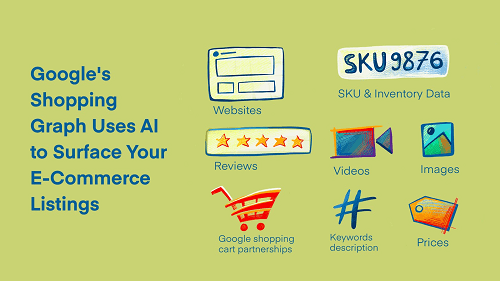The Google Shopping Graph
The google shopping graph builds on the existing knowledge graph and compiles shopping-related information for the user in an easy-to-read format. In addition, visitors on google will use pictures to find products. Google shopping graph, which primarily serves as a middle ground for retailers and shoppers, has many features that are useful to web admins and users.
How does it work?
Using AI software that integrates the Shopify model. This is a simple-to-use system that makes shopping on google easy.
“Building on the knowledge graph, the Shopping Graph brings together information from websites, prices, reviews, videos and, most importantly, the product data we receive from brands and retailers directly”. The AI-enhanced model works in real-time and is designed to show users relevant listings as they shop across Google.

The Google shopping graph
Google’s shopping graph brings together shoppers with billions of product listings from different shops and retailers. In addition, this expands into a partnership with Shopify.
In 2020, the pandemic caused a shift in consumer behaviour, resulting in a boom for e-commerce while local retailers were set back by social distancing and mandated lockdowns. Since then, new consumer preferences have emerged. More people than ever are turning to e-commerce or buy-online pick-up in-store (BOPIS) to replace traditional shopping experiences.
Google has also partnered with Shopify to enable 1.7 million merchants to show their products across Google Search, Shopping, Image search and YouTube. “With just a few clicks, these retailers can sign up to appear across Google’s one billion shopping journeys each day, from Search to Maps, Images to Lens and YouTube.
The key is making sure Google has access to as much information about your products as possible.
Google shopping graph SEO starts with high-quality listings.
Keyword-filled Descriptions
Google crawlers go through the text associated with your products to determine what you are selling and how closely it matches what customers are searching for. Regularly auditing the catalogue to ensure that the users make the most of listing character counts. This is why using SEO is such a valuable proposition for e-commerce websites.
Different Categories for Products
When given the opportunity, select as many relevant categories for products as possible. Not only will this help the Google Shopping Graph algorithm properly define products, but it is also a best practice for nearly all e-commerce marketplaces where users can list. Use Google Trends to see what keywords can relate as similar categories
Images and Videos
Users want to ensure that their product listings have clear and attractive multimedia. Using optimized text for images and videos can be a great way to increase listing rank on google. To continue to be driving forces in engaging customer attention and conveying the value of your products. Google Shopping Graph results rely on these, as well. Moreover, strong visuals will help Shopping Graph appearances stand out from the competition.


